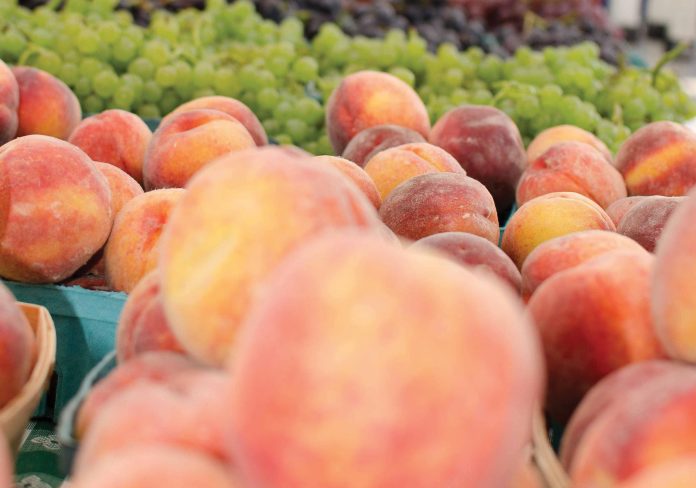
The South Side of Youngstown roared along with the exuberant decade of the 1920s. As thousands of people moved into that rapidly growing part of the city, one of Mahoning Valley’s most enduring icons was born: the Pyatt Street Market. Every year shoppers descended on the farmer’s market to inspect the colorful stalls, piled high with seemingly endless rows of fruits and vegetables. Generations of Youngstowners grew up with parents who brought them to a bustling venue that had been transformed from a city dump to one of the busiest farmers’ markets in Northeast Ohio.
The marker first opened around 1924 and initially operated year-round on Monday, Wednesday and Fridays from 1 to 10 p.m. It was centered at 66 Pyatt St. The stalls and vendors extended passed Lois Court to Erie Street and up Pyatt to Wayne Avenue. “In the summertime the Pyatt Street Market used to be so packed,” Joseph Rohovsky told YSU’s oral-history program in 1982. “And the traffic was so great you couldn’t even walk on the street.”
Along with other young children, Rohovsky earned pocket money by shelling peas and lima beans for vendors during the early 1940s. At the time, as many as 2,000 shoppers a day came through the market. In those days, neighborhood grocers dominated much of the grocery business in the city. Lacking the proper refrigeration to keep produce consistently fresh, owners regularly visited the market for fruits and vegetables. Married women made up the other largest group of shoppers, according to a Vindicator report from the time.
Farmers from a 50-mile radius routinely came to sell their wares. The market consisted of both an open-air section and a covered section where meats (including live chickens) and cheeses were sold. Shoemakers and vendors selling peanuts, popcorn and doughnuts all did business at Pyatt. Even an organ grinder and monkey often arrived to entertain shoppers. Business usually peaked in September and October when many women bought winter supplies for canning, according to Rohovsky.
“The crowds are ‘home-grown,’ too,” said Betty Lovell of the Junior League in 1955. “And every type is represented, from the elegant lady sporting slacks and a long cigarette holder, who sweeps up in her convertible, to the plainly-dressed, hard-working woman who walks over with her basket.”
The rise of supermarkets during the ‘50s and ‘60s began to hurt business at the Pyatt. According to “Mahoning Memories: A History of Youngstown and the Mahoning Valley,” Seventy percent of Youngstown’s neighborhood grocery stores closed between the end of World War II and 1970. Many farmers left the business altogether. “General Motors came, and a lot of the farmers’ children ended up working there,” Bill Umbel recalled. “They could make more money than they could breaking their backs on a farm.”
Umbel and Youngstown Food Distributors took control of the market in the early 1980s. Average daily attendance had declined to an average of 400 to 500 people a day, Umbel told the Vindicator in 1981.
In the mid-‘80s, Umbel and his wife, Janet, bought an old diner next to the market and rechristened it the Pyatt Street Diner. “We started out with just four booths, 11 bar stools and a table in the corner,” Umbel said. However, it quickly became a success.
The diner was known for selling pasta on Wednesday, beef on Thursday, fish on Friday and pork and lamb on Saturday. “We turned a diner with casual attire into a place with a white tablecloth menu,” Umbel explained. In 1989, Ohio Magazine gave the diner a star rating.
“It was really nostalgic,” said Don Attenberger. “The kind of old-time diner you just don’t see today.”
The Umbels also opened a jazz club in the basement called “Down Under.” “Some of the biggest names in jazz and blues would come through,” Umbel said. “They’d give us a decent price because it was an off night for them.” Local acts like Big Boogie D and Youngstown native and world-class guitarist Phil Keaggy thrilled audiences as well.
In 2000, the Umbels opened the Pyatt Street Diner II in Colony Square Plaza in Boardman. They wanted to provide a carryout option closer to the bulk of their clientele in the suburbs.
Yet the old market on Pyatt Street continued to struggle as crime rose on the South Side and younger customers failed to carry on the tradition of visiting farmers’ markets. “If I were a queen, I’d wave my magic wand and revive Youngstown’s Pyatt Street Market,” Jane Tims wrote in a 1998 Vindicator column. But it was not to be. By 2004, both the market and the diner had closed.
A 2012 fire destroyed much of the covered section of the abandoned market. However, there’s still one reason to visit Pyatt Street today. Pam and Ken Krantz have been coming there now for almost 40 years. They still operate their food truck, Kenny K’s Concessions, under the old canopy on Monday, Wednesday and Friday from April to December. “We’ve seen four or five generations come through here,” Ken said.
For a few dollars, you can buy a hot sausage sandwich and french fries and hear about the glory days of the old market. While you wait, you’re sure to see a diverse group of people pull up for the lunchtime rush.
“They just come,” Ken explained. “Just drive up Market Street and look down and see if we’re here,” Pam said.
After over 80 years, a small piece of Youngstown’s most treasured market still lives on.
© 2019 Metro Monthly. All rights reserved.







My great grandparents came from Switzerland in the early 1900’s and were farmers. They had one of the earliest greenhouses in town. I’m sure they must have been vendors at the Pyatt Street Market. Is a list of vendors available?
Hi Jill. Pinpointing vendors is tough. I doubt the market kept detailed records on seasonal vendors. Even photos are rare, but they surface from time to time.
My grandmother Stephanie Gasior and her husband Felix sold most of their produce at the Pyatt St Market . She lived first one Pyatt St and than closer on Wayne Ave . She was well known for her amazing Swiss chard and basil . Miss those days and wish I would have taken pictures when I had the chance
Hi! Are there any photos of Pyatt Street Market around?
Photos of the Pyatt Street Market are tough. Even our usual archival sources don’t have photos. That doesn’t mean they don’t exist. We just haven’t found them.